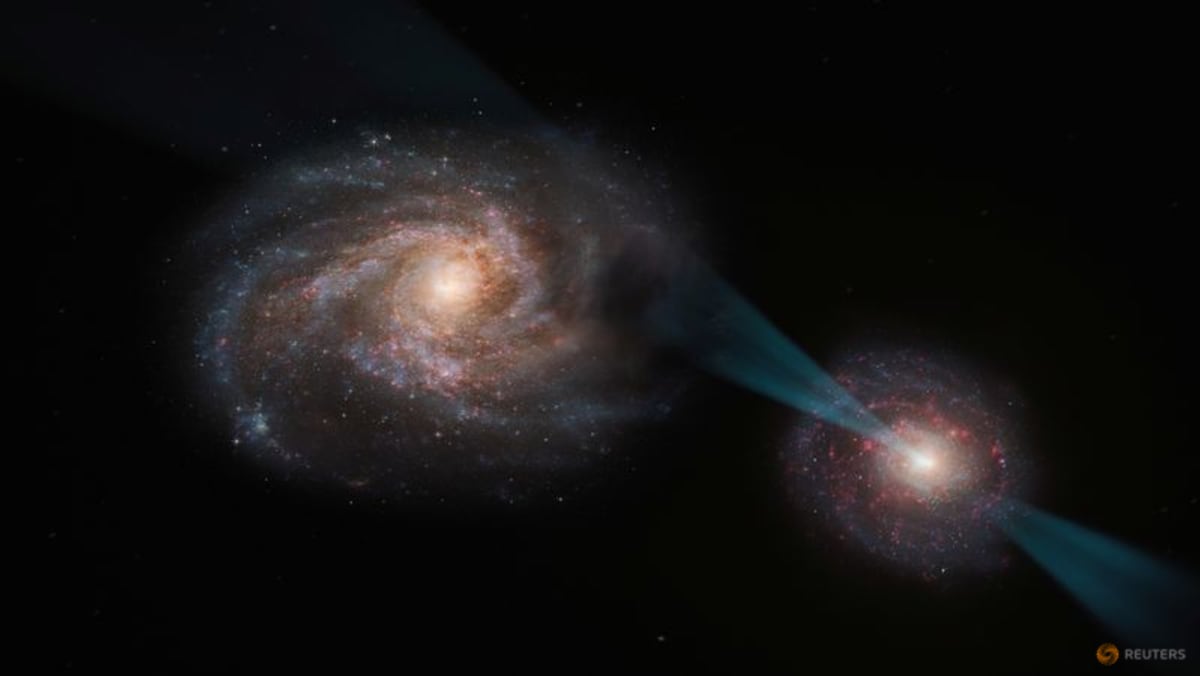WASHINGTON : Astronomers have observed two distant galaxies – both possessing roughly as many stars as our Milky Way – careening toward each other before their inevitable merger at a time when the universe was about a fifth its current age, a scene resembling two knights charging in a joust.
The galaxies, observed using two Chile-based telescopes, were seen as they existed about 11.4 billion years ago, approximately 2.4 billion years after the Big Bang event that initiated the universe.
At the heart of one of the galaxies resides a quasar, a highly luminous object powered by gas and other material falling into a supermassive black hole. The intense radiation across the electromagnetic spectrum unleashed by the quasar is seen disrupting clouds of gas and dust, known as molecular clouds, in the other galaxy.
It is molecular clouds that give rise to stars. But the effects of the quasar’s radiation turned the clouds in the affected region into “only tiny dense cloudlets that are too small to form stars,” said astrophysicist Sergei Balashev of the Ioffe Institute in Saint Petersburg, Russia, co-lead author of the study published on Wednesday in the journal Nature.
This is the first time such a phenomenon has been observed, Balashev said.
Stars form by the slow contraction under gravity of these clouds, with small centers taking shape that heat up and become new stars. But the galaxy affected by the quasar’s radiation was left with fewer regions that could serve as such stellar nurseries, undermining its star formation rate.
The interaction between the two galaxies reminded the researchers of a medieval joust.
“Much like jousting knights charging toward one another, these galaxies are rapidly approaching. One of them – the quasar host – emits a powerful beam of radiation that pierces the companion galaxy, like a lance. This radiation ‘wounds’ its ‘opponent’ as it disrupts the gas,” said astronomer and co-lead author Pasquier Noterdaeme of the Paris Institute of Astrophysics in France.
Supermassive black holes are found at the heart of many galaxies, including the Milky Way. The researchers estimated the mass of the one that serves as the engine of the quasar studied in this research at about 200 million times that of our sun.
The intense gravitational strength of the supermassive black hole pulls gas and other material toward it. As this stuff spirals inward at high speed, it heats up due to friction, forming a disk that emits extremely powerful radiation in two opposite directions, called biconical beams.
The ultraviolet light from one of these beams is what played havoc with the gas in the companion galaxy.
This supermassive black hole is much more massive than the one at the center of the Milky Way – called Sagittarius A*, or Sgr A* – which possesses roughly 4 million times the mass of the sun and is located about 26,000 light-years from Earth. A light-year is the distance light travels in a year, 5.9 trillion miles (9.5 trillion km).
The researchers used the Atacama Large Millimeter/submillimeter Array, or ALMA, to characterize the two galaxies and used the European Southern Observatory’s Very Large Telescope, or VLT, to probe the quasar as well as the gas in the companion galaxy.
The configuration of the galaxies as viewed from the perspective of Earth enabled the researchers to observe the radiation from the quasar passing directly through the companion galaxy.
Most galactic mergers that have been observed by astronomers occurred later in the history of the universe.
“Galaxies are typically found in groups, and gravitational interactions naturally lead to mergers over cosmic time,” Noterdaeme said. “In line with current understanding, these two galaxies will eventually coalesce into a single larger galaxy. The quasar will fade as it exhausts the available fuel.”













